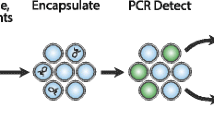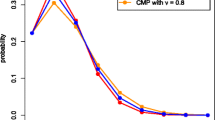Abstract
During the last decade, the viability PCR approach has been investigated intensively with the goal of detecting solely the DNA derived from intact cells by removing the bias resulting from dead or damaged cell artifacts. However, since the first published paper in 2003 and despite the various continuous improvements, the stubborn reality is that in most cases the goal has not been achieved. Complete neutralization of nucleic acids derived from dead microorganisms was not possible, at least without affecting live cells. However, recently published works in this field show how neutralization rates can be improved. In this communication, we review recent improvements that enable effective vPCR procedures.
Similar content being viewed by others
References
Nguyen LD, Deschaght P, Merlin S, Loywick A, Audebert C, Van Daele S, Viscogliosi E, Vaneechoutte M, Delhaes L (2016) Effects of propidium monoazide (PMA) treatment on mycobiome and bacteriome analysis of cystic fibrosis airways during exacerbation. PLoS One 11(12):e0168860. https://doi.org/10.1371/journal.pone.0168860
Carini P, Marsden PJ, Leff JW, Morgan EE, Strickland MS, Fierer N (2016) Relic DNA is abundant in soil and obscures estimates of soil microbial diversity. Nat Microbiol 19(2):16242. https://doi.org/10.1038/nmicrobiol.2016.242
Luo JF, Lin WT, Guo Y (2010) Method to detect only viable cells in microbial ecology. Appl Microbiol Biotechnol 86(1):377–384. https://doi.org/10.1007/s00253-009-2373-1
Ditommaso S, Ricciardi E, Giacomuzzi M, Arauco Rivera SR, Ceccarelli A, Zotti CM (2014) Overestimation of the Legionella spp. load in environmental samples by quantitative real-time PCR: pretreatment with propidium monoazide as a tool for the assessment of an association between Legionella concentration and sanitary risk. Diagn Microbiol Infect Dis 80(4):260–266. https://doi.org/10.1016/j.diagmicrobio.2014.09.010
Fittipaldi M, Codony F, Adrados B, Camper AK, Morató J (2010) Viable real-time PCR in environmental samples: can all data be interpreted directly? Microb Ecol 61(1):7–12. https://doi.org/10.1007/s00248-010-9719-1
Nikolayevskyy V, Miotto P, Pimkina E, Balabanova Y, Kontsevaya I, Ignatyeva O, Ambrosi A, Skenders G, Ambrozaitis A, Kovalyov A, Sadykhova A, Simak T, Kritsky A, Mironova S, Tikhonova O, Dubrovskaya Y, Rodionova Y, Cirillo D, Drobniewski F (2015) Utility of propidium monoazide viability assay as a biomarker for a tuberculosis disease. Tuberculosis (Edinburgh) 95(2):179–185. https://doi.org/10.1016/j.tube.2014.11.005
Rogers GB, Stressmann FA, Koller G, Daniels T, Carroll MP, Bruce KD (2008) Assessing the diagnostic importance of nonviable bacterial cells in respiratory infections. Diagn Microbiol Infect Dis 62(2):133–141. https://doi.org/10.1016/j.diagmicrobio.2008.06.011
Elizaquível P, Aznar R, Sánchez G (2014) Recent developments in the use of viability dyes and quantitative PCR in the food microbiology field. J Appl Microbiol 116(1):1–13. https://doi.org/10.1111/jam.12365
Zeng D, Chen Z, Jiang Y, Xue F, Li B (2016) Advances and challenges in viability detection of foodborne pathogens. Front Microbiol 22(7):1833. https://doi.org/10.3389/fmicb.2016.01833
Nogva HK, Drømtorp SM, Nissen H, Rudi K (2003) Ethidium monoazide for DNA-based differentiation of viable and dead bacteria by 5'-nuclease PCR. Biotechniques 34(4):804–8, 810, 812–3
Fittipaldi M, Nocker A, Codony F (2012) Progress in understanding preferential detection of live cells using viability dyes in combination with DNA amplification. J Microbiol Methods 91(2):276–289. https://doi.org/10.1016/j.mimet.2012.08.007
Trevors JT (2012) Can dead bacterial cells be defined and are genes expressed after cell death? J Microbiol Methods. 90(1):25–28. https://doi.org/10.1016/j.mimet.2012.04.004
Codony F, Agustí G, Allué-Guardia A (2015) Cell membrane integrity and distinguishing between metabolically active and inactive cells as a means of improving viability PCR. Mol Cell Probes 29(3):190–192. https://doi.org/10.1016/j.mcp.2015.03.003
Lee S, Bae S (2018) Evaluating the newly developed dye, DyeTox13 green C-2 Azide, and comparing it with existing EMA and PMA for the differentiation of viable and nonviable bacteria. J Microbiol Methods 148:33–39. https://doi.org/10.1016/j.mimet.2018.03.018
Cao Y, Zhou D, Li R, Yu Y, Xiau X, Zhou A, Liu D, Li X (2019) Molecular monitoring of disinfection efficacy of E. coli O157:H7 in bottled purified drinking water by quantitative PCR with a novel dye. J Food Process Preserv 43:e13875. https://doi.org/10.1111/jfpp.13875
Gailard C, Strauss F (1998) Avoiding adsorption of DNA to polypropylene tube and denaturation of short DNA fragments. Tech Tips Online 3:63–65
Moreno L, Aznar R, Sánchez G (2015) Application of viability PCR to discriminate the infectivity of hepatitis A virus in food samples. Int J Food Microbiol 18(201):1–6. https://doi.org/10.1016/j.ijfoodmicro.2015.02.012
Agustí G, Fittipaldi M, Codony F (2017) False-positive viability PCR results: an association with microtubes. Curr Microbiol 74(3):377–380. https://doi.org/10.1007/s00284-016-1189-3
GenIUL Tech Note (45000146–00) (2016) Understanding the tube contribution in vPCR results. Res Gate Res. https://doi.org/10.13140/RG.2.1.4109.2722
Dinh Thanh M, Agustí G, Mader A, Appel B, Codony F (2017) Improved sample treatment protocol for accurate detection of live Salmonella spp. in food samples by viability PCR. PLoS One 12(12):e0189302. https://doi.org/10.1371/journal.pone.0189302
Lizana X, López A, Benito S, Agustí G, Ríos M, Piqué N, Marqués AM, Codony F (2017) Viability qPCR, a new tool for Legionella risk management. Int J Hyg Environ Health 220(8):1318–1324. https://doi.org/10.1016/j.ijheh.2017.08.007
Pan Y, Breidt F Jr (2007) Enumeration of viable Listeria monocytogenes cells by real-time PCR with propidium monoazide and ethidium monoazide in the presence of dead cells. Appl Environ Microbiol 73(24):8028–8031
Kralik P, Nocker A, Pavlik I (2010) Mycobacterium avium subsp. paratuberculosis viability determination using F57 quantitative PCR in combination with propidium monoazide treatment. Int J Food Microbiol 141(1):S80–S86. https://doi.org/10.1016/j.ijfoodmicro.2010.03.018
Agustí G, Fittipaldi M, Codony F (2018) Optimization of a viability PCR method for the detection of Listeria monocytogenes in food samples. Curr Microbiol 75(6):779–785. https://doi.org/10.1007/s00284-018-1448-6
Bolton PH, Kearns DR (1978) Spectroscopic properties of ethidium monoazide: a fluorescent photoaffinity label for nucleic acids. Nucleic Acids Res 5(12):4891–4903
Graves DE, Watkins CL, Yielding LW (1981) Ethidium bromide and its photoreactive analogues: spectroscopic analysis of deoxyribonucleic acid binding properties. Biochemistry 20(7):1887–1892
Soejima T, Iwatsuki KJ (2016) innovative use of palladium compounds to selectively detect live enterobacteriaceae cells in milk by polymerase chain reaction. Appl Environ Microbiol 23:1613–1616. https://doi.org/10.1128/AEM.01613-16
Soejima T, Minami J, Xiao JZ, Abe F (2016) Innovative use of platinum compounds to selectively detect live microorganisms by polymerase chain reaction. Biotechnol Bioeng. 113(2):301–310. https://doi.org/10.1002/bit.25711
Randazzo W, López-Gálvez F, Allende A, Aznar R, Sánchez G (2016) Evaluation of viability PCR performance for assessing norovirus infectivity in fresh-cut vegetables and irrigation water. Int J Food Microbiol 16(229):1–6. https://doi.org/10.1016/j.ijfoodmicro.2016.04.010
Lee JL, Levin RE (2009) Discrimination of viable and dead Vibrio vulnificus after refrigerated and frozen storage using EMA, sodium deoxycholate and real-time PCR. J Microbiol Methods 79(2):184–188. https://doi.org/10.1016/j.mimet.2009.08.014
Seidel L, Strathmann M, Nocker A (2017) The feasibility of improved live-dead distinction in qPCR-based microbial source tracking. J Microbiol Methods 140:23–31. https://doi.org/10.1016/j.mimet.2017.06.013
Takahashi T, Gao Y, Miya S, Kuda T, Kimura B (2017) Discrimination of live and dead cells of Escherichia coli using propidium monoazide after sodium dodecyl sulfate treatment. Food Control. https://doi.org/10.1016/j.foodcont.2016.06.022
Kontchou JA, Nocker A (2019) Optimization of viability qPCR for selective detection of membrane-intact Legionella pneumophila. J Microbiol Methods. 156:68–76. https://doi.org/10.1016/j.mimet.2018.12.003
Dong L, Liu H, Meng L, Xing M, Wang J, Wang C, Chen H, Zheng N (2018) Quantitative polymerase chain reaction coupled with sodium dodecyl sulfate and propidium monoazide for detection of viable Staphylococcus aureus in milk. J Dairy Sci S0022–0302(18):30292–30293. https://doi.org/10.3168/jds.2017-14087
Lee HW, Lee HM, Yoon SR, Kim SH, Ha JH (2018) Pretreatment with propidium monoazide/sodium lauroyl sarcosinate improves discrimination of infectious waterborne virus by RT-qPCR combined with magnetic separation. Environ Pollut 233:306–314. https://doi.org/10.1016/j.envpol.2017.10.081
Coudray-Meunier C, Fraisse A, Martin-Latil S, Guillier L, Perelle S (2013) Discrimination of infectious hepatitis A virus and rotavirus by combining dyes and surfactants with RT-qPCR. BMC Microbiol 13:216. https://doi.org/10.1186/1471-2180-13-216
Marotz CA, Sanders JG, Zuniga C, Zaramela LS, Knight R, Zengler K (2018) Improving saliva shotgun metagenomics by chemical host DNA depletion. Microbiome 6(1):42. https://doi.org/10.1186/s40168-018-0426-3
Lu J, Zheng H, Chu P, Han S, Yang H, Wang Z, Shi J, Yang Z (2018) Direct detection from clinical sputum samples to differentiate live and dead Mycobacterium Tuberculosis J Clin Lab Anal 33(3):e22716. https://doi.org/10.1002/jcla.22716
Pérez LM, Fittipaldi M, Adrados B, Morató J, Codony F (2013) Error estimation in environmental DNA targets quantification due to PCR efficiencies differences between real samples and standards. Folia Microbiol (Praha). 58(6):657–662. https://doi.org/10.1007/s12223-013-0255-5
Pacholewicz E, Buhler C, Wulsten IF, Kraushaar B, Luu HQ, Iwobi AN, Huber I, Stingl K (2019) Internal sample process control improves cultivation-independent quantification of thermotolerant Campylobacter. Food Microbiol 78:53–61. https://doi.org/10.1016/j.fm.2018.09.017
Randazzo W, Vasquez-García A, Aznar R, Sanchez G (2018) Viability RT-qPCR to distinguish between HEV and HAV with intact and altered capsids. Front Microbiol 9:1973. https://doi.org/10.3389/fmicb.2018.01973
Agustí G, Codony F (2018) Commentary: reducing viability bias in analysis of gut microbiota in preterm infants at risk of NEC and sepsis. Front Cell Infect Microbiol 20(8):212. https://doi.org/10.3389/fcimb.2018.00212
Acknowledgements
Mai Dinh-Thanh would like to thank the Erasmus plus program and higher education traineeships from the European Commission for their financial support during her stay at GenIUL research laboratories. The authors would like to thank Dr. Andreas Nocker for his kind review of this work.
Author information
Authors and Affiliations
Corresponding author
Additional information
Publisher's Note
Springer Nature remains neutral with regard to jurisdictional claims in published maps and institutional affiliations.
Rights and permissions
About this article
Cite this article
Codony, F., Dinh-Thanh, M. & Agustí, G. Key Factors for Removing Bias in Viability PCR-Based Methods: A Review. Curr Microbiol 77, 682–687 (2020). https://doi.org/10.1007/s00284-019-01829-y
Received:
Accepted:
Published:
Issue Date:
DOI: https://doi.org/10.1007/s00284-019-01829-y




